Team-BHP
(
https://www.team-bhp.com/forum/)
Introduction & Availability
Ford India has launched the Figo and Aspire with the option of a dual clutch 6-speed automated gearbox, known as the PowerShift transmission. This transmission was previously offered in the Fiesta between 2011-2014, and is also offered in the EcoSport since 2013. However, it is only now that Ford are actively pushing this transmission option, both in the Figo/Aspire, as well as by way of increased supply for the EcoSport. Given the likelihood of this transmission becoming more popular on our roads, I've put together this thread to discuss how this particular model of transmission works. While this thread focuses on this model of transmission, many principles are equally applicable to other dual-clutch transmissions, such as the Volkswagen Direct Shift Gearbox (DSG) DQ200 and DQ250.
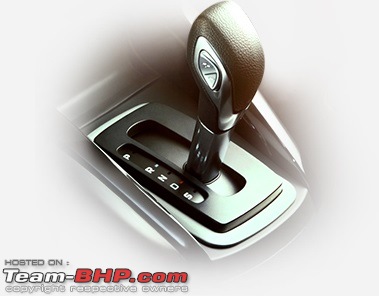 Image copyright Ford Motor Company What is a Dual-Clutch Transmission?
Image copyright Ford Motor Company What is a Dual-Clutch Transmission?
It is a type of transmission that has two clutches to drive separate gears. Each clutch drives a separate set of gears, with one clutch serving the odd-numbered gears and another the even-numbered gears. When one clutch is engaged and driving the car on one gear, the gearbox can select the next gear (one higher or one lower) on the other clutch, but with that clutch disengaged. At the appropriate RPM, that clutch is engaged and the other one is disengaged, resulting in a gear change.
These transmissions blend good old gearbox mechanicals with electro-mechanical or electro-hydraulic actuators, electrical motors, and control electronics. The control electronics has software that assesses various input and initiates gear changes.
The Ford PowerShift DCT
Ford uses the term PowerShift or DCT to refer to their dual-clutch transmissions. The DCT that comes in the Figo, Aspire and EcoSport is known as the DPS6 model. This is manufactured by Getrag who refer to it as their 6DCT250 model. Given below are the specifications:
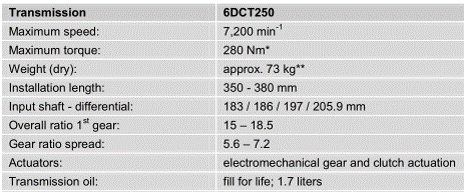
Although we use the generic terms transmission and gearbox, technically this is what is known as a transversely mounted transaxle. 'Transversely' means the crankshaft's axis is perpendicular to the direction of travel. Most modern cars that have a front-wheel drive configuration have a transversely mounted engine and transmission. 'Transaxle' means that the gearbox and differential are combined into one unit, and this drives the half-shafts for each driven wheel. The below illustration shows the location of the PowerShift transaxle:
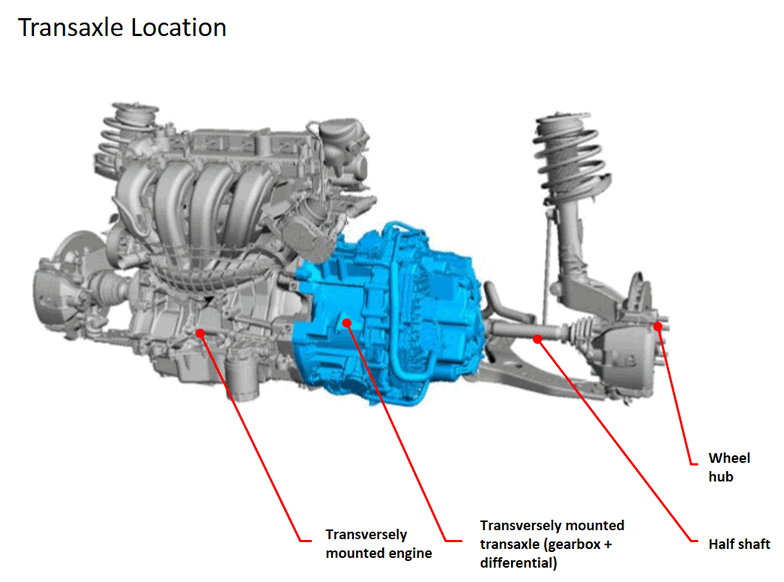 Image copyright Ford Motor Company Notable Features
Image copyright Ford Motor Company Notable Features - This DCT uses a dry clutch, that does not bathe the clutches in oil for cooling. This increases efficiency.
- Filled with oil and sealed for life (10 years or 240,000 kms) - it does not require periodic maintenance.
- Has a dry weight of 73 kg - given that it literally consists of a subset of 2 transmissions, plus additional components (for comparison, the Getrag iB5 gearbox that Ford uses as a 5-speed manual transmission has a dry weight of ~35 kg).
Benefits - Quicker gear shifts and lower transmission losses
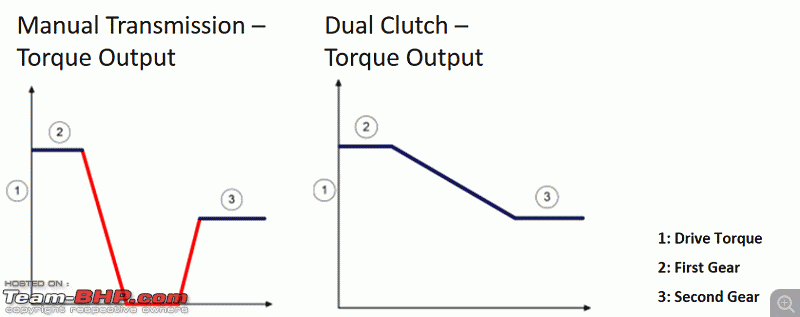
- Electro-mechanical actuators removes the need for hydraulic lines
- Dry clutch does not require cooling lines
Drawbacks - Shift logic can be confused by driver input, resulting in slow gear changes
- Complexity, can lead to problems and difficulty in repairs
- Manufacturers are shifting away from dry clutch gearboxes to wet clutches due to improved reliability and thermal constraints (even in low torque applications which was the domain of dry clutches). For example, Getrag's newer 6DCT150 gearbox is a wet-clutch setup despite a lower torque rating
Components of the DCT
As mentioned previously, a DCT mechanically consists of 2 manual transmissions that interact very smartly through the use of electricals and electronics. So, if you're not familiar with how manual transmissions work, it would be useful to read up on that first:
http://auto.howstuffworks.com/transmission2.htm.
This gearbox combines standard gearbox mechanicals, electro-mechanical actuators and control electronics. We'll now take a run through schematics that help build up these components into the overall gearbox. These schematics are meant to illustrate the concept and are not accurate in terms of dimensions - so please excuse any oddities (e.g. 6th gears not touching!)
Dual Clutches and Dual Input Shafts
Firstly, we look at the torque input side, namely the dual clutches, and the shafts they are connected to.
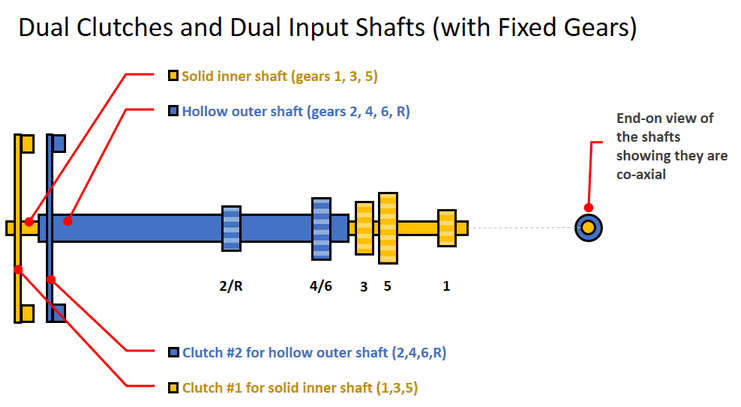
- There are 2 input shafts, one of which is hollow (blue) and the other is solid (yellow) and sits coaxially within the hollow shaft.
- The inner shaft (yellow) has fixed gears for gears 1, 3 and 5; while the outer shaft (blue) has fixed gears for 2, 4, 6 and reverse. Note that this shaft has only 2 physical gears, each of which are used for 2 gear positions.
- Each of these shafts are connected to a clutch via splines on the outside of the shaft.
- This arrangement allows for compact packaging of both clutches.
- Unlike other clutches seen in manual transmissions, in the normal resting state the clutch is held open by springs (i.e. it won't transmit torque), and needs to be actuated to close, and are held closed by a holding current applied to the actuator.
- The transmission electronics ensures that only one clutch is closed at any time.
Output Shafts 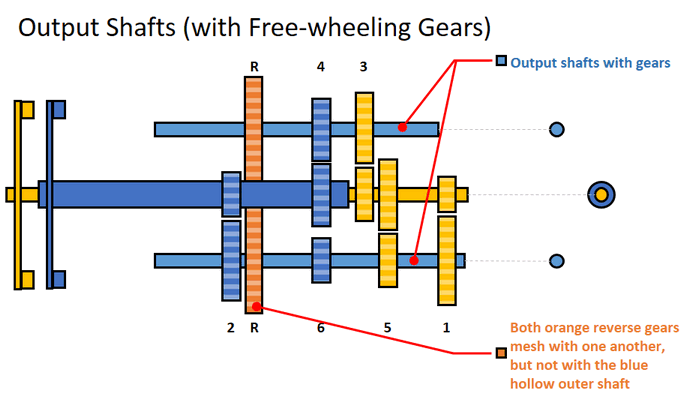
- The gearbox has two output shafts (shown in cyan/pale blue). Contrary to initial thoughts, these don't carry gears corresponding to the input shafts. Instead, the gears they carry are determined by the order of the selector forks.
- The gears on the output shafts are not fixed, but are free-wheeling. Like a manual transmission, they are equipped with synchronizers to match speeds and lock the gears.
- Gears 1, 3,4, 5, 6 and reverse are equipped with a single synchronizer, while gear 2 is double synchronized.
- The second gear is coupled to the reverse gear on the same shaft (although both can free-wheel when not engaged, they do so together).
- Note that the orange reverse gears on both output shafts are engaged directly with one-another. However, they do not engage with either the yellow or blue input shafts.
- As a result, the output shafts and input shafts are not in the same plane - instead they're arranged in a triangular formation (see the end-on view on the right of the above image).
Differential 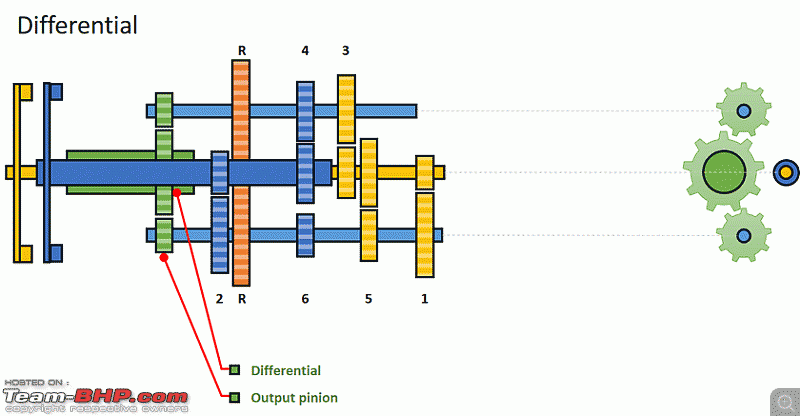
- Both output shafts transfer torque via the output pinion to a common differential shaft (shown in green).
- This differential shaft is not in the same plane as the output shafts, it is again offset - the 4 shafts are arranged in a parallelogram formation (see the end-on view in the above image).
- The differential serves the same purpose as a MT-equipped car - it allows each of the driven wheels to rotate at different speeds (e.g. when turning).
Synchronizer Sleeves & Selector Forks 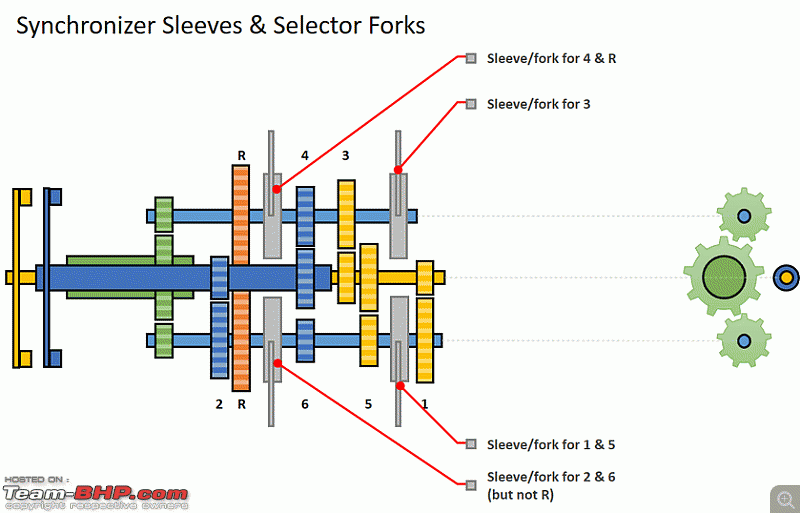
- When discussing the output shafts, I mentioned that none of the gears are fixed to the shafts, but are instead free-wheeling.
- There are 4 synchronizer sleeves (and associated assemblies) that allow these free-wheeling gears to match the speed of the output shaft, and to lock the gears. 3 of these sleeves are used to engage two gears (at separate times), while 1 sleeve is used for just a single gear.
- Each of these synchronizer sleeves have a corresponding selector fork, that can move the sleeve to either side (to lock a gear) or to the middle (to unlock a gear).
Until this point, the components we've seen are all familiar, since they closely resemble manual gearboxes - rather,
two gearboxes, since we have two clutches, two input shafts and two output shafts. It is only at the differential that both these units are unified into a single output. From this point onwards is where the 'magic' of a DCT happens.
Shift Actuators 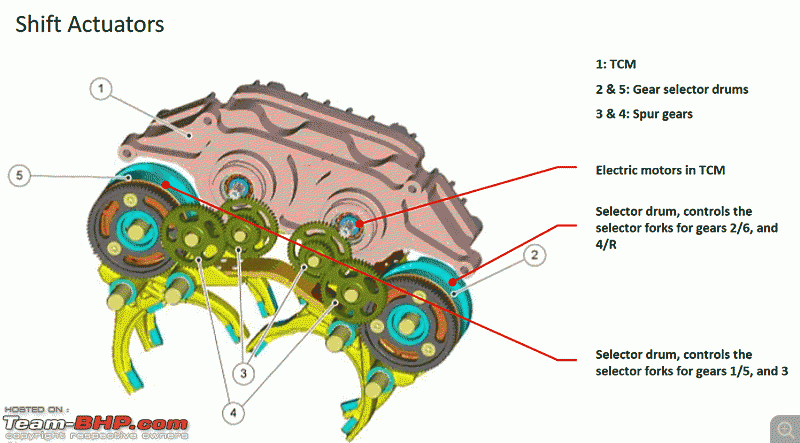 Image copyright Ford Motor Company
Image copyright Ford Motor Company - While we'll come to the TCM itself in more detail later.
- For now we need to focus on the two electric motors present in the TCM, as they provide rotational output from the TCM, to actuate the selector forks.
- The motors are of a brushless DC design. They have Hall sensors built in to determine the position of the rotor, and count the number of rotations it has gone through.
- Via a system of spur gears, these rotate selector drums through a specific angle (the range of travel for these drums is 200 - 290 degrees).
- The selector drums have a slot cut in them. The selector forks have a tongue that sits in this slot.
- The slot is angled towards the ends of the travel, so that when the selector drum rotates, the tongue is forced perpendicular to the direction of rotation (i.e. parallel to the axis of the selector drum). If this is confusing to understand, imagine how a screw converts the rotational motion of the screwdriver into forward motion.
- By this, a rotational motion produced by the electric motors can be converted into front-to-back movement of the selector forks. This allows the selector forks to move the synchronizer sleeves forward or backward to lock and unlock specific gears.
- In comparison, in a manual transmission the selector forks are manually controlled by the linkages to the gear lever.
Clutch Actuators 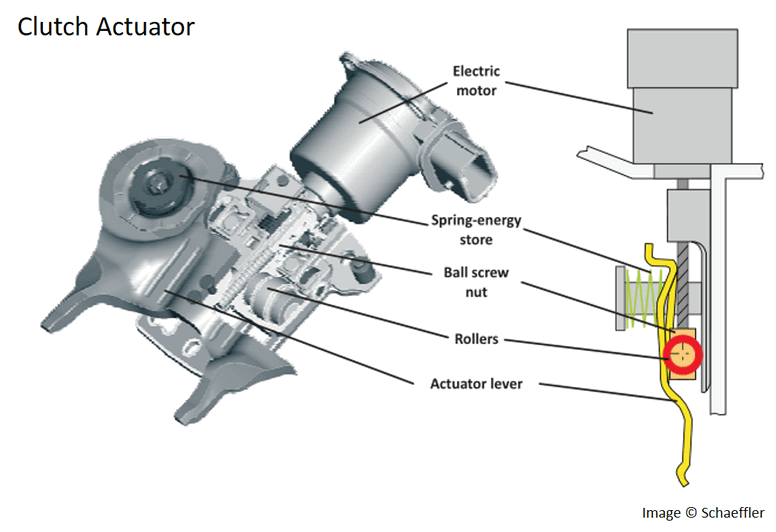
- Similar to the shift actuator, the clutch actuator converts the motion of an electric motor into lateral motion.
- Once again, a brushless DC motor is used.
- As mentioned previously, the clutch is held open by spring pressure, by default, and doesn't transmit torque.
- To close the clutch, the motor rotates a worm gear, that pushes the clutch actuator.
- To keep the clutch closed, a holding current is applied to the motor.
- The following 2 animated images is a representative view of how each of the clutches are actuated. For info, these are clutches in a VW DSG, but the principle is the same.
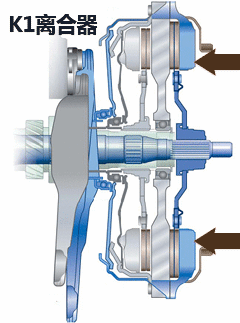
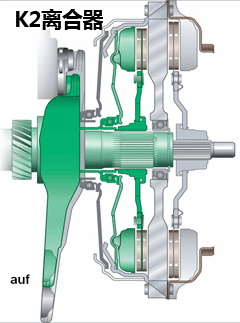
- Image credit autohome.com.cn
Transmission Control Module (TCM)
Until now, we've seen the components that go into the plain gearbox, and we've seen the actuating components (i.e. the muscles) that move things in the gearbox. We now come to the TCM, which is the brain of the DCT.
In the image for the shift actuators, you've seen the pink unit described as the TCM. Here's a view of the other side of it, which has input connectors from the ECU. The side opposite to this has the output of the 2 motors that we'd seen earlier.
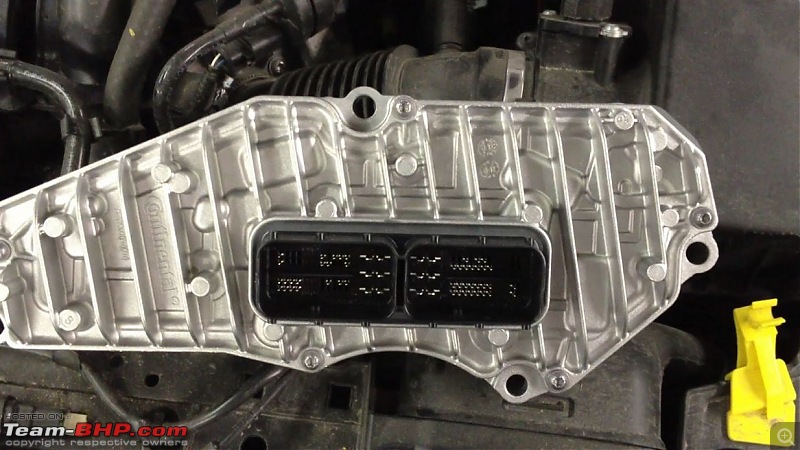
- The TCM collects input signals from various sensors, assess the input, and control the actuators accordingly. The principle is simple, the execution is complex!
Input used by the TCM includes:
- Transmission range (P/R/N/D/S/L, etc.)
- Vehicle speed
- Engine speed and engine torque
- Throttle position
- Engine temperature
- Ambient temperature (to decide how viscous the transmission oil is, for cold starts)
- Steering angle (to avoid upshifts or downshifts during cornering)
- Brake inputs
- Input shaft speed (for both input shafts)
- Vehicle attitude (tilt) from the body control module (BCM)
The TCM controls the actuator motors via an open-loop control, to allow adaptive control. This allows the TCM to identify and adapt to the following:
- Clutch engagement points (F1 fans will have heard of the 'clutch bite point')
- Clutch friction coefficient
- Position of each synchronizer assembly
Information for the above are stored in non-volatile RAM in the TCM. This is what constitutes the learnt driving patterns for a particular gearbox.
In a later section, we will look at the various driving modes and how the TCM determines the appropriate course of action for them.
Sensors
There are multiple sensors that gather and provide information to the TCM, both from within the DCT, and elsewhere within the vehicle. Those associated with the DCT itself are:
- Input shaft speed sensor (ISS sensor) - a magneto-resistive sensor - one per input shaft
- Output shaft speed sensor (OSS sensor) - again, a magneto-resistive sensor - one sensor, attached to the differential
- Transmission range sensor (TR sensor) - to detect the position of the selector lever, and convert it to a PWM signal
Cutaway
Thus far, we've been looking mostly at simplified schematics. Here's a 3-D cutaway of the real thing:
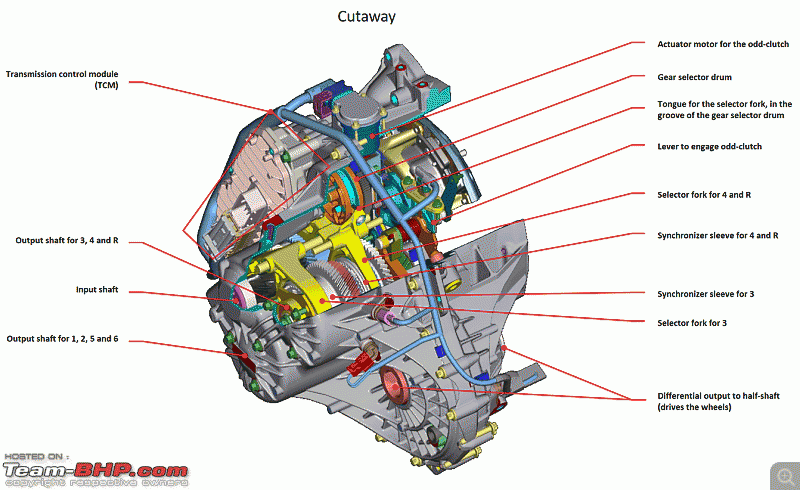
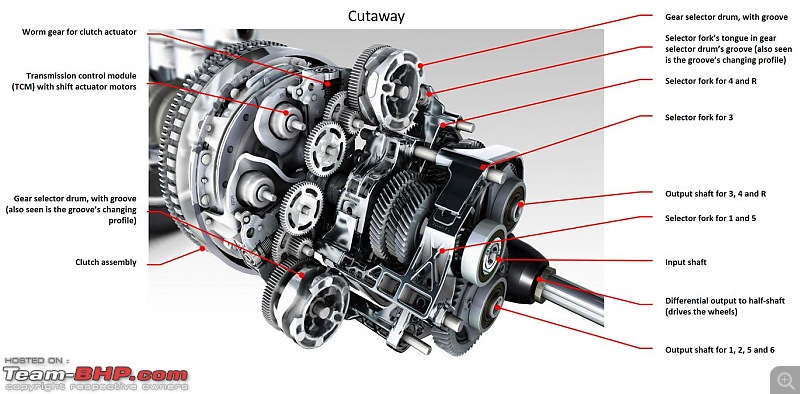 Images copyright Ford Motor Company
Images copyright Ford Motor Company
Power Delivery
This DCT has 6 forward gears, and a reverse. The following images show how, upon actuation, the selector forks and synchronizer sleeves engage different gears. In all cases, torque delivery from the input clutches to the differential is indicated with a broken red line. Clutches, shafts and gears that are free-wheeling are represented with faded colours. For initial clarity, I'm only showing the selection of a single gear used to drive the output, and am not showing the pre-selection of the next gear. These images took a few hours to create, so please be gentle if there are any errors!
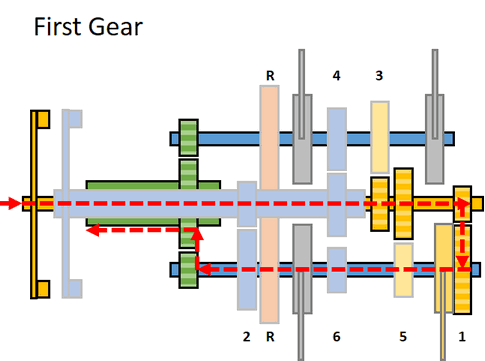
- Clutch 1 is actuated (closed), and engine torque comes in through the inner (yellow) input shaft.
- Clutch 2 is not actuated, so it automatically opens.
- The sleeve/fork for gears 1/5 is actuated to lock gear 1.
- Note that both output shafts rotate even though only the lower output shaft is driven directly by the input - the top shaft rotates as it is driven indirectly by the differential and the pinion.
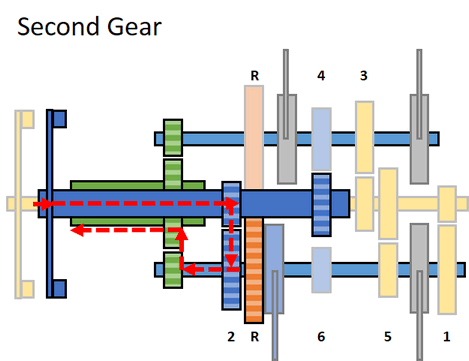
- Clutch 1 is not actuated, so it automatically opens.
- Clutch 2 is actuated (closed), and engine torque comes in through the outer (blue) input shaft.
- The sleeve/fork for gears 2/6 is actuated to lock gear 2. Remember that the second gear is coupled to the reverse gear on the same shaft.
Gears 3 - 6 follow a similar pattern as the first 2 gears, so no description is provided.
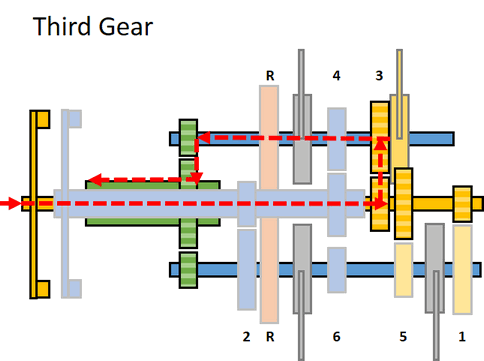
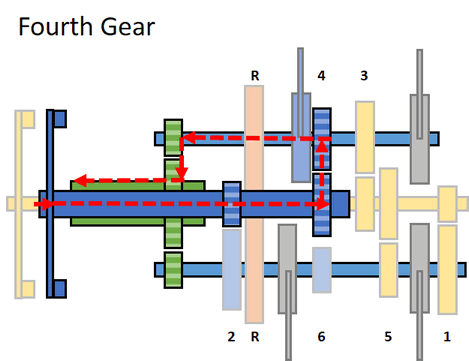
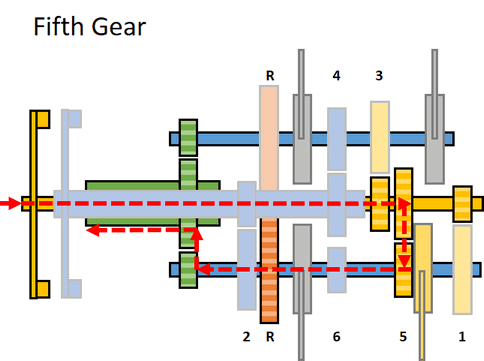
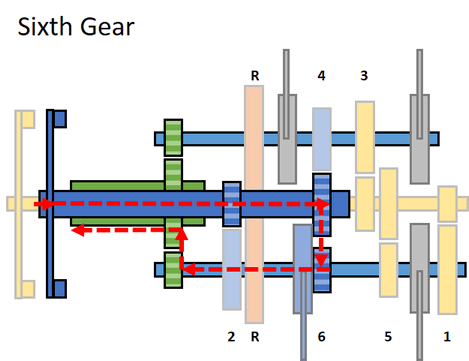 Reverse Gear
Reverse Gear 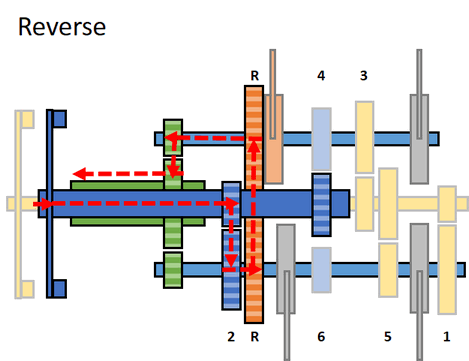
- Just like a manual transmission has an idler gear to reverse the direction of the output shaft, the DCT has an intermediate gear, which is coupled to the second gear.
- Clutch 1 is not actuated, so it automatically opens.
- Clutch 2 is actuated (closed), and engine torque comes in through the outer (blue) shaft.
- The sleeve/fork for gears 4/R is actuated to lock gear R on the upper shaft. Remember that both orange gears are directly meshed to one-another. This results in the intermediate gear reversing the direction of the upper shaft.
Pre-Selection of Gears
For clarity, in the preceding diagrams I'd not shown how pre-selection works. In reality, the DCT always has another gear engaged (but with its corresponding clutch open). The below illustration shows how when 1st gear is engaged, 2nd gear is pre-selected.
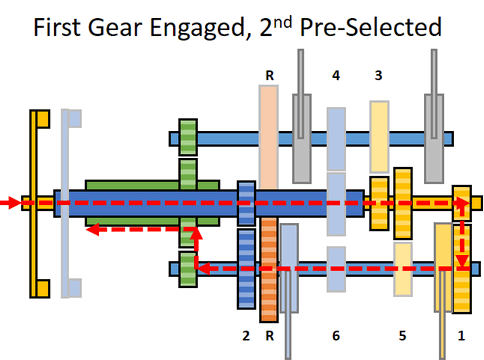
- 1st gear is selected, as shown previously.
- In addition to this, the sleeve/fork for gears 2/6 is actuated to lock gear 2. However clutch 2 is not actuated, so it is open.
- The lower output shaft rotates due to 1st gear being engaged. Since 2nd gear is also locked on this shaft, this rotates the outer (blue) input shaft. This also means that this shaft is speed matched to the vehicle speed in 2nd gear.
- If the gear pre-selected is on the other output shaft, even in that case the other output shaft will rotate as it is driven by the differential and output pinion.
- When a gear shift is initiated by the TCM, only the clutches need to be actuated to open clutch 1 and actuate clutch 2 (and outside the TCM, the engine speed has to be lowered to match the upshift).
- The TCM then pre-selects the next gear appropriately.
- The TCM can pre-select either a higher or lower gear, based on the input it receives.
- When the expected gear shift matches the pre-selected gear, the gear change occurs very fast.
- However, when the expected/requested gear shift does not match the pre-selected gear, the gear change is slower, since the correct gear has to be selected before swapping clutches. This can result in a noticeable pause before the gear changes.
- While the TCM algorithms are tuned to cater to various driving conditions (and are continually improved), they cannot cater to external factors which are apparent to a driver.
Sport Mode and SelectShift Mode - Sport (S) mode allows the engine to rev higher before upshifting.
- It allow allows driver requests for upshifts and downshifts via the +/- button.
- These are only 'requests' because the TCM will assess this against other inputs before initiating a gear shift - for example, this prevents downshifting at high rpm to avoid entering the redline
Park (P) Mode 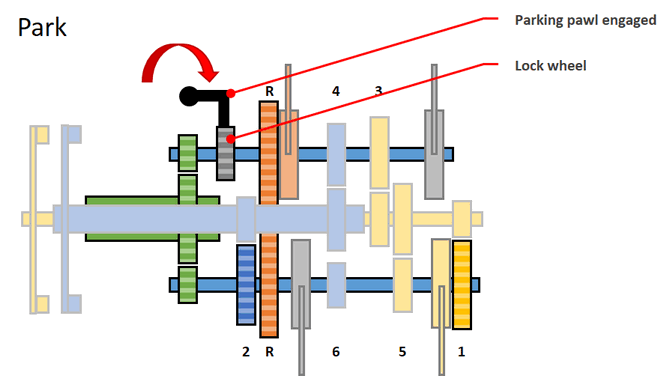
- A parking pawl is engaged on the output shaft to ensure the output shaft doesn't rotate.
- The pawl (pin) is spring-loaded to ensure it doesn't jump out unless disengaged.
- Both clutches are not actuated, so they both automatically open.
- The shift actuators lock gears 1 and R - since taking a car out of P will result in one of these gears being selected.
- The owner's manual recommends also setting the parking brake (hand brake), to ensure that this mechanism does not take the whole strain of holding the vehicle (e.g. on a slope, for instance).
Hill Start Assist - This feature is not intrinsic to the DCT, it also uses the brake system.
- When the vehicle is in a stopped state on an incline that exceeds 3 degrees, hill launch assist is activated.
- The brake system is pressurised to hold the vehicle until sufficient torque has built up to move the vehicle. This can take 2-3 seconds.
- This allows the driver to move their right foot from the brake to the accelerator without having the vehicle roll back.
Neutral Coast-Down / Neutral Idle - The clutches will disengage when the brakes are applied.
- This increases fuel economy, improves coasting downshifts and improves clutch robustness.
Warning Modes & Limp Home Mode - If the clutch temperature is found to be rising, warnings are generated to instruct the driver to halt the vehicle until the clutch cools down. The driver can also accelerate the vehicle to cool the clutch through airflow (clutches can overheat in stop-and-go traffic).
- To help reduce clutch heating, the clutch will be engaged more quickly than normal, and engine torque reduced.
- If the clutch temperature exceeds 300 degrees centigrade, the clutches are disengaged.
- If one of the clutch actuator motors fails, then the transmission adapts to this by using only the gears on the other clutch.
- If the speed sensors fail on the input shaft, then the gears on that shaft are blocked.
- If the TCM itself or TR sensor (transmission range) fail, then both clutches are disengaged and the vehicle cannot be driven.
- These failure modes will trigger the MIL/CEL (malfunction indicator light/check engine light).
Common Characteristics
The automated nature of a DCT means that users might notice sounds or behaviour that is (or seems) different from a normal manual transmission. Some of these are normal and expected, and need not be a cause for concern.
- Double clicking metal sounds: These noises can likely be heard while driving on very smooth surfaces during a 1-2 upshift or a 3-2-1 coast down. The sounds occur with every gear engagement, but generally cannot be heard over the background engine, road and wind noises at higher speeds. These sounds are of the shift forks moving and the synchronizers engaging a gear (similar to a manual transmission). These shifting sounds are part of normal operation.
- Coast down whine: A slight gear whine while slowing or coasting is normal.
- Clicking sounds after the engine is turned off: As the vehicle is powered down, the transmission will cycle the clutches to the released position so it is ready for a safe restart of the engine. This is part of normal operation. Clicking sounds from the transmission immediately after the engine is turned off are normal.
- Low-speed grinding: A slight grinding noise may be heard at about 3 km/h. This noise is more evident during multiple accelerator on/off events. This noise is caused by a normal bearing rotation and does not affect the durability of the transmission.
- Reverse gear whine: Some PowerShift transmissions will exhibit gear whine in reverse. This is characteristic of many manual transmissions, and is not a defect.
- Bumping feeling: Some may experience a slight bumping feel. This may occur in lower forward gears – particularly if the driver is off and on the accelerator quickly. It may be more noticeably in a parking lot or when a driver is doing multiple on/off accelerator manoeuvers. This is a normal characteristic of the dry clutch-equipped manual transmission design. Conversely, conventional automatic transmissions are equipped with a torque converter. The torque converter is a fluid coupling device which dampens these positive engagements feels.
New transmissions require a break in period before they start shifting smoothly. During the break-in period, they may exhibit:
- A rattle noise similar to a loose catalytic converter shield. This noise is commonly heard after light-accelerator triggered 1-2, 2-3 or 3-4 upshifts. This rattle noise will diminish greatly as the clutch completes the break-in.
- A take-off shudder/launch judder (shaky vs. smooth).
- A harsh-shift feel during the first few cold shifts before the transmission reaches operating temperature.
All of the above conditions will diminish, and progressively better launches and smoother shifts will be observed within the first few hundred kilometers of mixed driving as clutch break-in occurs.
Common Problems
If you thought only Volkswagen's DQ200 DSG transmission was plagued with problems, think again. A search for "PowerShift problems" throws up a host of results! Ford has worked diligently in releasing software updates via technical service bulletins (TSBs) to address most (if not all) of these issues.
- Oil contamination - early gearboxes in 2011 had problems of oil or grease entering the clutch housing. As this is a dry clutch, this resulted in poor performance. This is a mechanical issue that has been resolved.
- Grounding issues - early gearboxes in 2011 had a poor electrical grounding connection in some cases, resulting in erratic behaviour (loss of drive, shifting into neutral). This is a mechanical issue that has been resolved.
- RPM surge, RPM oscillations, shudder, jerky shifts, gear hunting - These issues don't affect everyone. Ford are continually updating the firmware are issue various TSBs. Some EcoSport owners have themselves received such updates and have noticed a change in behaviour.
Despite these issues, Getrag has had success with this gearbox, and from the start of production in 2010, it quickly went on to producing a million gearboxes of the 6DCT250 model by 2012 itself. Below is a photo of the one-millionth gearbox coming off the line:
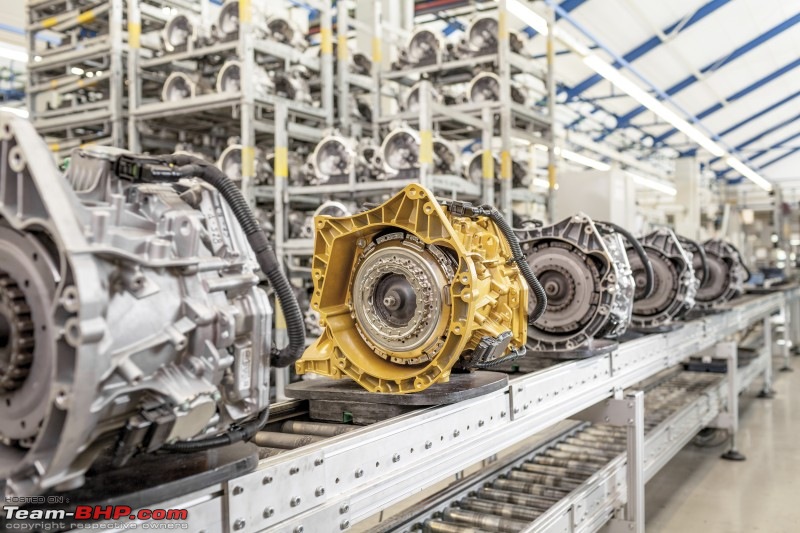
For more information, check out this brilliant 1-hour video that examines the transmission in detail. I watched it thrice to write this thread!
https://www.youtube.com/watch?v=6iCRnAUftvI
This is an excellent thread. For a long time I was searching technical details on this Gearbox but was unable to find such a comprehensive view. Thanks a ton, for bringing it all together.
Great thread. Why would manufacturers think dry clutch would be better considering the amount of friction expected? Must be a reason though, I am not getting it!
Nice thread Arun. Very informative. Do you have any material on how this compares and differs with VW's DQ200 DSG. For example, we know both are dry clutch boxes, VW has 7 gears which this DCT has 6.
Would be interesting to see what other similarities/differences are from a technical perspective (if any).
Also Interesting to read that the DCT has also had reliability issues but looks like Ford has been more proactive in taking care of it.
Might be OT here but was wondering whether Ford is offering a lifetime warranty on the box? It also might vary from one country to the other I guess.
That is a great and in-depth writeup on the working of the DCT. Great one. As rajeevraj indicated, It would be great to have a comparison with the DQ200 since they are similar tech.
Also in general, since these gearboxes have dual clutch, Will the clutch life be doubled in this case since the load is shared by two instead of a single clutch in a manual shift car?
Quote:
Originally Posted by Rajeevraj
(Post 3812681)
Do you have any material on how this compares and differs with VW's DQ200 DSG.
...
Also Interesting to read that the DCT has also had reliability issues but looks like Ford has been more proactive in taking care of it.
|
And to add why is DSG more "popular" in terms of talking public compared with DCT?
Example: you may even check our forum where most people talk about DSG because of super fast transmission shifts, but those same people never talk about DCT!
Quote:
Originally Posted by Figopian
(Post 3812669)
Why would manufacturers think dry clutch would be better considering the amount of friction expected?
|
Manufacturers use dry-clutches in low-torque applications, since the lower torque will presumably mean that the clutch does not generate as much heat. This allows them to cut down on the associated oil plumbing to cool the clutch, which in turn makes the gearbox perform better (lesser pumping losses), simpler and lighter (therefore cheaper).
However, real-world experience has proven that this is not as simple as originally thought. While low-torque engines do reduce the load on the clutch, such engines are usually present in small cars (hatchbacks, sub-compact sedans, etc.). The tight packaging in the engine bay has conversely resulted in heat being retained, even if much is not generated in the first place.
That's the reason manufacturers are now looking at improving the efficiency of wet-clutch set-ups.
Quote:
Originally Posted by Rajeevraj
(Post 3812681)
Do you have any material on how this compares and differs with VW's DQ200 DSG.
|
Quote:
Originally Posted by praveen_v
(Post 3812766)
It would be great to have a comparison with the DQ200 since they are similar tech.
|
I've not checked for much material about this. The key differences I came across while researching this piece are:
- The 7-speed DQ200 DSG (made by Borg-Wagner) has faster shifts (up and down) compared to the Getrag 6DCT250 and shifts gears smoother, according to various reviews
- A much more user-friendly tiptronic mode in the VW DSG, with paddle shifters
- The DQ200 uses electro-hydraulic actuators (using transmission oil), while the 6DCT250 uses electro-mechanical actuators. Electro-mechanical is slightly preferable as its easier to manage and control, and has a smaller power budget (same reason why electric-assisted steering has displaced hydraulic-assisted steering).
Quote:
Originally Posted by praveen_v
(Post 3812766)
Also in general, since these gearboxes have dual clutch, Will the clutch life be doubled in this case since the load is shared by two instead of a single clutch in a manual shift car?
|
Nice angle to your question :). The answer is yes - the gearbox is sealed and does not require maintenance for 10 years 240,000 kms, under normal driving conditions. Do bear in mind that city driving conditions in India are far from normal, and might accelerate wear. Also, poor driving habits like using the accelerator to hold the vehicle on a slope can easily fry a clutch (and unlike a manual, since your left leg is no longer finely balancing the clutch, you might not even realize that you're doing this).
Quote:
Originally Posted by ike
(Post 3812750)
was wondering whether Ford is offering a lifetime warranty on the box?
|
Previously, there was confusion over whether the 'sealed for life' constituted a warranty also; but none of the documentation indicated this was a warranty. However, a member has pointed out on either the Figo or Aspire thread that he'd seen material referring to a 10 year warranty (couldn't locate that post, sorry!). I've not seen any other confirmation other than this one item.
Quote:
Originally Posted by alpha1
(Post 3812779)
And to add why is DSG more "popular" in terms of talking public compared with DCT?
|
I came to know of dual-clutch transmissions only through the term "DSG". Moreover, VAG had introduced DSG on their higher-end products (Jetta, etc.) and then allowed it to trickle down, giving it the aura of a 'halo' technology. Even today, reading the words DSG gives me a little thrill (of course, I then think DQ200 which quickly wipes that smile off my face).
On the other hand, Ford launched the DCT with their ill-fated 2011 Fiesta which was a sales dud. And although they also launched the DCT with the EcoSport in 2013, for two years availability of the EcoSport AT was lousy, with dealers reluctant to take orders for it. So, DCT is a relatively unheard of term outside of enthusiast circles in India. Now is the time that perception might finally change, with the Aspire AT and Figo AT. The Figo AT has an uphill battle on its hands, since the easiest reference is the stellar turbocharged Polo TSI (price differences notwithstanding).
Folks, I drive a Ecosport Automatic, the transmission it uses is the 6DCT150 which has a wet clutch. The transmission is sealed and warrantied for 10 yrs and 200000 km if I remember right. It is not the 6DCT 250 with the dry clutch. The 6 DCT150 is rated at 170nm which is compatible with the 1.5 liter engine with 150nm.
Found the specs of the transmission Ford is using.
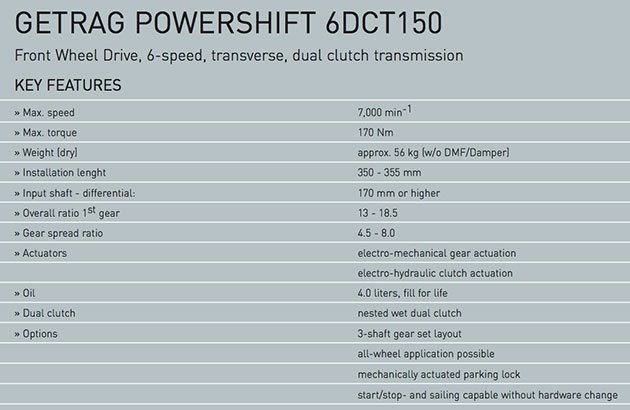
Quote:
Originally Posted by ssingri
(Post 3812912)
Folks, I drive a Ecosport Automatic, the transmission it uses is the 6DCT150 which has a wet clutch. It is not the 6DCT 250 with the dry clutch.
|
If you see the below VIN decoding of a 2015 EcoSport, it lists the transmission as a DPS6, which is Ford's name for the dry-clutch 6DCT250. I'd be surprised if they're giving more than one type of 6-speed transmission in the same car, particularly since wet clutches require oil lines from the engine.
To be really sure, you could verify your VIN yourself at
https://www.etis.ford.com/.
Quote:
Originally Posted by Grand Drive
(Post 3782692)
It's Ford Ecosport July 2015 model.
Build Date: 22.07.2015
Engine: 1.5L Duratec Ti-VCT (110PS) - Sigma
Transmission: 6 Speed Auto Transmission DPS6
|
Quote:
Originally Posted by arunphilip
(Post 3812847)
Nice angle to your question :). The answer is yes - the gearbox is sealed and does not require maintenance for 10 years 240,000 kms, under normal driving conditions. Do bear in mind that city driving conditions in India are far from normal, and might accelerate wear. Also, poor driving habits like using the accelerator to hold the vehicle on a slope can easily fry a clutch (and unlike a manual, since your left leg is no longer finely balancing the clutch, you might not even realize that you're doing this).
|
The 10 year warranty was offered in Fiesta. Though even this warranty was not able to bring in fresh customers.
There is no news of such warranty on the new Aspire / Figo.
| All times are GMT +5.5. The time now is 09:25. | |



























